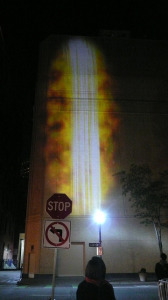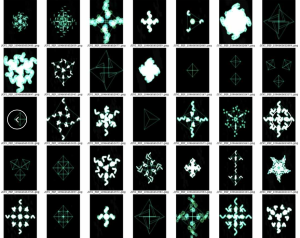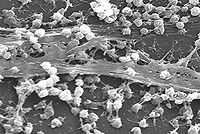
Watch. The water falls on the bridge and then travels along the pipe. It goes along the pipe. Are you watching? Watch the water. I’ll show you again.
There are microbes all over us, in every orifice and covering our skins, but those in the gut have special influence. This internal village plays a role in the regulation of immunity and anxiety, perhaps aging too. How can stomach bacteria have such power? One possible reason: these creatures help us metabolise food, which makes them gatekeepers for nutrition. Some researchers believe humans co-evolved with gut bacteria, that tie between nourishment and development is so tight. But this still doesn’t seem sufficient to explain why the microbiome might be complicit in neurological problems, like Autism Spectrum Disorder (ASD). Even once you realize there are neurons (brain sensors) in the stomach too.
I became interested in the microbiome because it’s a distributed system. Like a rioting crowd, like musical notes in a chord. Each member of its community can be identified but the whole system can be characterized too. This dual quality – individual / system – is my focus here.

That part/whole dualness might offer a way to address medical problems that elude current methods. Some of those ailments span numerous body processes, which means they are distributed too. For example, Autism Spectrum Disorder exhibits gastrointestinal, neurological and psychological traits, which can surface together or in isolation. Current scientific models can account for each individual system, but struggle to track interactions between them. Studies of mice have shown that transplanting bacteria from one stomach to another can transform rodent anxiety into zen. How does unhealthy stomach bacteria make someone afraid?
My personal experience with autism is through a young family member. He is four, and has received contrary diagnoses in two separate ASD assessments: one positive, one negative. This affectionate, bilingual child has a quality of music, with repetitions that jar him occasionally, then disappear, only to return as more normal refrains later. His behavioral glitches are usually accompanied by stomach pain. For all the formalism in scientific autism analysis, I haven’t seen anything yet that touches on this quality of chords.
Contextual Diagnosis
Chords: emotional, digestive and social. They harmonize or not. Only some combinations change his ability to process information. He has a ragged toy dog named Snuggie that he endows with power over each kind of situation. He keeps this creature close whenever he eats, sleeps or listens to stories. Snuggie is an emotional lever, pounded to threads.
What is normal? A boy digs in the sand, scooping a hole then filling it, only to do it again, mesmerized by a quality of holeness. It seems pathological until another boy joins him, two excavators enchanted by raw materials. Perhaps there is nothing wrong with him, and there are simply different species of boy. Some are talkers, others are interactors and a few look at a soft rise of dirt and see a ready page. I ask him what he’s making and he says, “a hole.” Whenever I ask a question like this, the answer is usually the thing itself. The hole isn’t a swimming pool or a cave, it isn’t even a hole made by a boy. In his story, the hole wants to be made, and its edges like to be angular. The absence of humanness takes me by surprise. My writerly self finds narrative surprises beautiful, but it’s a flag for ASD in the tests.
After leaving him alone to play, I return later and see he has drawn lines in the dirt, perfectly straight rails. He asks me to follow his finger as he traces the drawing, and if I glance away for a moment he gets upset, as though I’ve missed a critical part of the story. His descriptions grow more repetitive when he needs attention. The emotional grasping causes him to repeat. Is that all it is? A stutter of attachment. I’ve seen extreme forms of autism in other kids and there’s nothing conditional about it. ASD is not based on circumstance. But in the case of this boy, I’m not sure.
A philosophical leap: context

These are the train rails. They go along like this, like this, are you watching? They start here and go along. And the next one starts here and goes along. You aren’t watching. Here let’s start again.
Currently, biological systems are modeled from the bottom up. This is necessary because those are the tools we have. The problem is, in bottom-exclusive models, systems become the sum of their parts, and nothing else. In these models, the triggers for disease or cure must be individual bacteria or chemicals. It’s hard to think of medicine another way and not have it collapse into quackery. However, this bottom-up approach struggles in cases where a causal factor isn’t a particular element, but some overall quality of a system. In these cases, the ability to characterize whole systems – as well as their interactions at the tiny level – becomes important.
One study of bacterial communities in the gut found that the microbiome might depend on qualities of whole systems to guard against dangerous infections, such as Clostridium difficile. This flora can harmlessly occupy some stomachs, yet overcolonize others, producing a toxic emission that erodes the stomach lining. That study concluded:
“difficile resistance was never attributable to a single organism, but rather it was the result of multiple microbiota members interacting in a context-dependent manner.”

Context is more than the sum of its parts. There are different individual/system properties. The system level requires it’s own method of reasoning, a meta-method that would act as a sort of umbrella for elemental approaches, picking up where they leave off. Contextual reasoning has ways of its own.
Situation theory emerged from Stanford in the 1980s to determine what these mechanisms were, with Barwise and Perry studying the way information shifts between situations that are only partially known. This development was a response to issues that were emerging in artificial intelligence, where computer systems were less clever than hoped, and adequate contextual information was proving hard to encode. At Stanford, Keith Devlin observes that when trying to represent the interpretive effects of context, “the horizon of understanding continues to recede with every cycle of increased explanation. Quite simply, the task is endless”.
Situation theory made an important inroad. It identified the problem and found a way to notate the absence of context-level dynamics. (If you’re curious how it is expressed, here is an example). But researchers (including myself) have only just started to unpack the spectrum of those dynamics.
A grammar of Context

I’m making up a song, okay? Are you listening? We’re going to clean up the room, clean up all the toys. Max and Sam and dad-dy, here we go. And the trucks go over here and the cars go in the box. At the end we watch a rocket, ha ha ha.
The boy’s songs aren’t repetitive. There are people and some causality in them, things ASD can’t usually do. Perhaps digging in sand is the problem. Maybe sometimes a context can encode a narrative tic, just as the shape of a nanotech sensor depends on its chemical bonds.
I imagine all the systems bearing on him: the microbial community feeding his body, the activities of that body informing social engagement, and those interactions framed by memory, which in turn depends on neurological structure. Sometimes it matters which systems govern. When one is dominant, does it impose its mode of operation on the others, the way it does in narrative inference? This is how stories produce unexpected ideas.
Here’s another way narrative makes context effects visible: analogy. When one system is placed in relation to another, it’s information is constrained, and at the same time, the salient structures extend each other. What does that mean? Here is an example: the boy’s illness is like music.
A metaphor is more than the sum of its parts. The analogues of illness and music limit each other’s individual definitions through their connection. Illness often carries a sense of physical deterioration that fades in the metaphorical phrase. Music also usually includes tangible qualities: an art of sound in time. Instead, in the combined analogy, systemic qualities are drawn out based on the way the two fields are similar to each other. This one way to characterize a system. A new, shared identity emerges from the correlation: disordered chords. It’s a simple example of a context-level mechanism.
Time is another important contextual factor. With each change in a system, its characterization alters. In essence, the next state resituates everything that came before. Each stride of time is another context. That shift indicates how the system can shift. Causal factors of disease and health could emerge from that transitional space. In the air between steps.
Diagnostic Swarms

I can help you fix the chair. That isn’t the right screwdriver. Daddy has another one, I’ll get it. You have to hold the sides so there’s a hole. The screw goes through the hole.
The microbiome is unique from another perspective: intervention. It is a foreign community within, symbiotically invested in good human health. In some form, it is communicating with human systems, to maintain this healthy state. It would be a good place to put a sensor, to eavesdrop on the latest update.
It is harder to eavesdrop on the rest of the body. When illness occurs, the body can simply commune with itself, perhaps in a pulse of registration. But the microbiome is a foreign entity, so perhaps there is some sort of language involved in its interaction with us that is more detectable, although still in a primordial form.
Gut sensors are small and distributed. Singularly, each would not be able to record anything too complex. I’ve heard they can be programmed, just not with much. But together, they would be capable of registering the scope of a system, not only its components. A sensor soup, a liquid eye that can flush through a system, in order to characterize it.

These minuscule sensors are being developed so they can speak a language of shape. Some would be built as a minuscule ‘plate’ with carefully shaped nodes. These can collect pieces of body flotsam while surfing through your gut. Only certain elements will fit in the spaces provided. Currently these sensors are basic compounds used to explore how to seed self-assembling structures of biota. At the end, you find the plate again, and examine what has accrued, and understand more about the demographics and dynamics of a digestive system.
This approach is bottom-up in the sense of materials: the shape of the bottom provides information when it collects elements that fit. (Another connection to narrative inference). This is not to be confused with conceptual bottom-up approaches. Here, only the individuals in a system can be represented, rather than a community, or a language.
What would a top-down approach look like, in nanotech diagnosis? Sensors would be endowed with a way to collect information about biotic interactions at the level of community, not just individual elements. Perhaps they would be introduced to the body and build according to what was going on around them, to reflect the process of making structure. What would the sensors look for, to capture collaborative biome dynamics? What are the punctuations of a primordial language?

Here is something interesting. Microbes build communities in the form of biofilms. Often a community will knit into a film by attaching to the intestine wall. Researchers suspect the combined structure of biofilm and intestine acts as a filtering veil. When something bad enters the gut, that film combats the intruder. At the same time, that merged community communicates with the walls of the intestine, so it can alert the human immune system.
Or not. Biofilms have also been linked to cancer. It would be good to be able to see and predict what is going on.
Communities of bacteria behaving like an organ. Defense as a topographical language. The mechanisms of analogy might help us characterize disorders. Maybe gut sensors could read those systems, and the exceptions to them.
One final remark – the exceptions are important. A context is transformed by an exception, as Kuhn observed. Perhaps this boy isn’t the only person whose behavior eludes diagnosis using generalized methods. This situation is unique – many people probably think it about their kin. But diagnosing and treating individuals rather than conditions is a bit labor-intensive, using our current approaches. It would require a very different kind of medicine.
The National Academies Keck Futures Initiative (NAKFI)
Every year, the National Academies Keck Futures Initiative (NAKFI) runs a think-tank to innovate future inventions, with blue-sky aspiration. In the past, collaborators have mostly been scientists; this year, artists are included too. My group will design nanotech sensors that can monitor bacterial gut communities. Photographs of work from the collaborating artists Niccolo Casas, Andrea Polli, Alison Kudla and Ruth West are featured in this post.
The 2015 forum will run from November 11-14 at the Arnold and Mabel Backman Center in Irvine.

